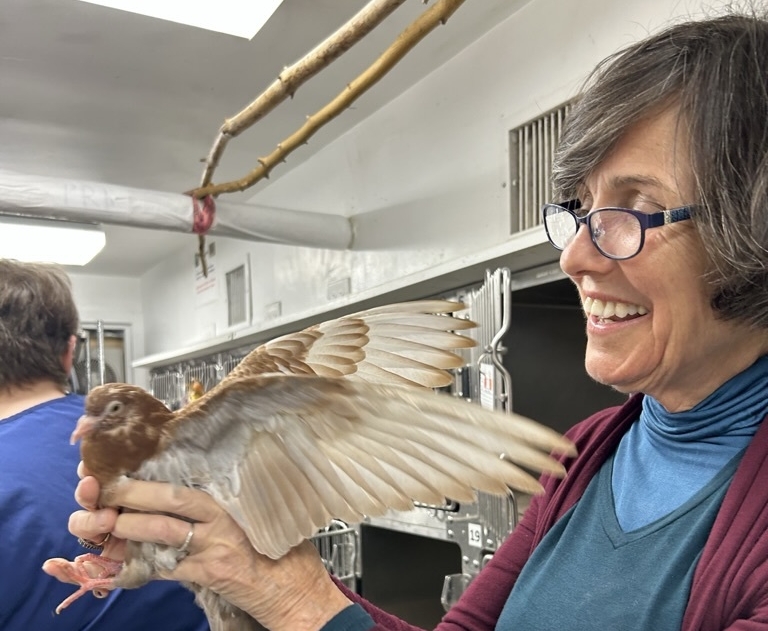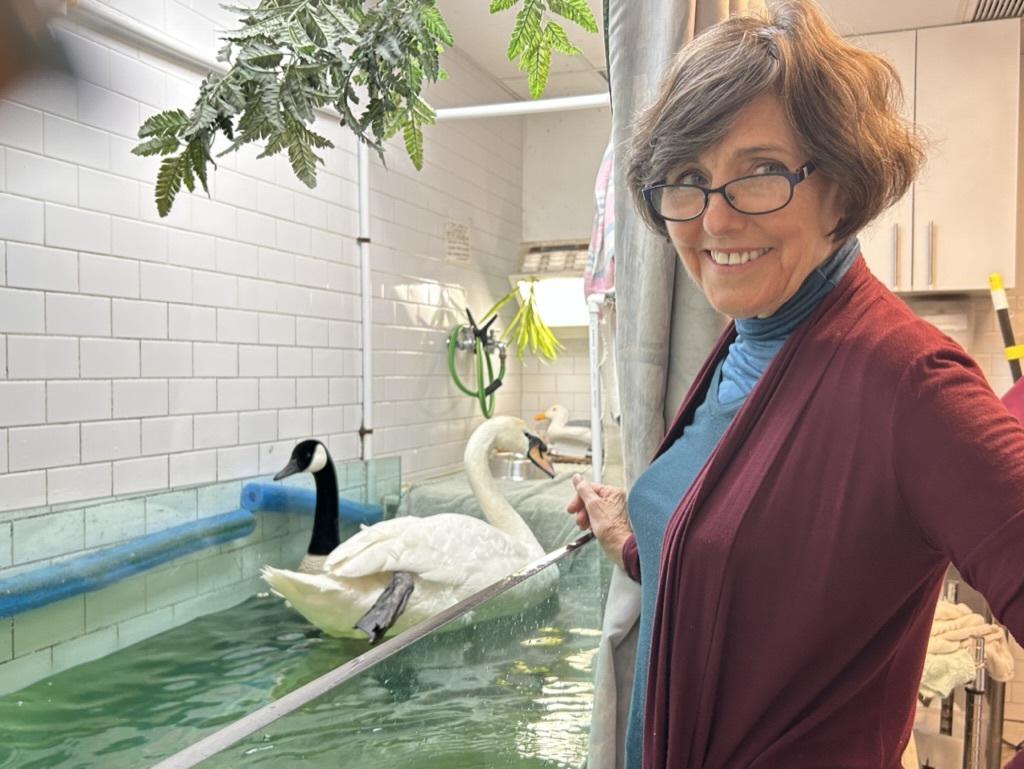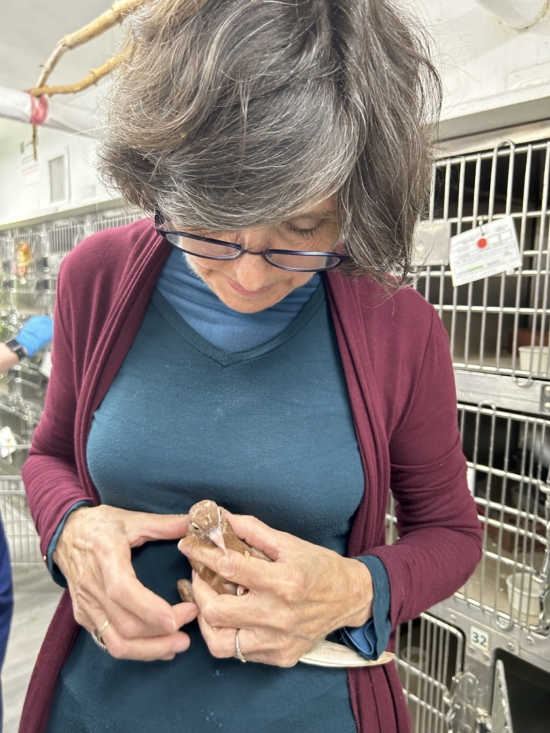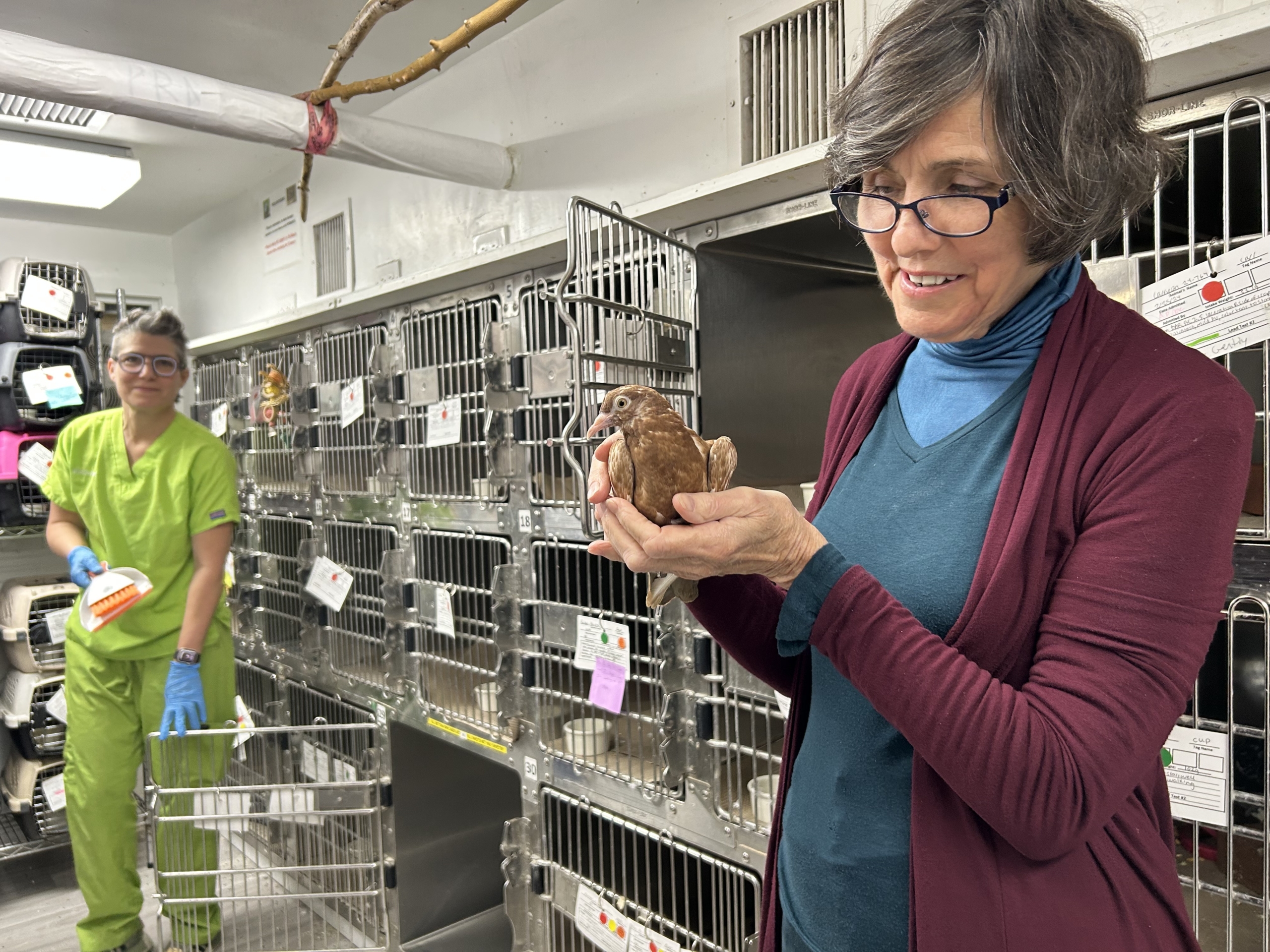
By Andrea Sachs
People appear at the front door of the Wild Bird Fund on Columbus Avenue at West 87th Street 365 days a year. They come carrying injured birds or small animals, held gingerly in paper bags or boxes, or even in their hands. One recent day, a Central Park Conservancy volunteer rushed in with a turtle who had swallowed a hook. A worried young couple arrived with an injured pigeon they found on the Brooklyn ferry. Nearby, Moby, a graceful swan, paddled around a large tub, waiting to finish his treatment for lead poisoning, so the Wild Bird Fund can move him permanently to a sanctuary away from the park in Brooklyn where he got sick.
When a crisis hits – whether it’s a lowly city pigeon, a small wild animal in Central Park, or an exotic bird migrating through the city – many Manhattanites know where to go: the nonprofit Wild Bird Fund (WBF), where Rita McMahon and a contingent of staffers and volunteers run the only urban wildlife center in the country. In fact, it was WBF’s hotline that was immediately called when Flaco, the now-immortal Eurasian eagle-owl, crashed into a building on West 89th Street in February. And it was the WBF staff who determined Flaco was dead and informed the Wildlife Conservation Society, which came to retrieve his body.
“Rita and the team at the Wild Bird Fund are an essential lifeline for injured birds in NYC,” said Dr. Dustin Partridge, Ph.D., the New York City Audubon Society’s director of conservation and science. “Each year, up to 250,000 birds die due to window collisions, and many more are injured and left to die slowly on the streets of NYC,” said Partridge. When NYC Audubon finds an injured bird, they rush it to the Wild Bird Fund, he said, “with the hope that the team there can apply lifesaving veterinary measures. Rita’s vision for the Wild Bird Fund has not only saved individual birds but has given them a voice that can help drive bird-safe change across NYC.”
For her loving, hands-on treatment of and advocacy for our avian and animal neighbors, West Side Rag is naming Rita McMahon, founder and executive director of the Wild Bird Fund, April’s Upper West Sider of the Month.

To spend time with McMahon at work is to experience the compassion and concern she and her colleagues have for the smallest and most vulnerable Upper West Siders.
Take the turtle who was brought in with a hook in its mouth: immediately, trained staff members huddled around the scared animal. When they were unable to remove the rusted hook, long embedded in the turtle’s mouth, throat, and gastrointestinal system, they referred the turtle on for further efforts at the Long Island Bird and Exotics Veterinary Clinic.
Despite their care, not every story has a happy ending. When the couple brought in the pigeon from the Brooklyn ferry they filled out a comprehensive intake form, donating $50 to defray the costs of treatment (the Wild Bird Fund’s primary source of revenue is individual tax-deductible donations). The center did blood tests and put the pigeon in an isolated room on antibiotics, but the bird rapidly went downhill. He was euthanized two days later when he could no longer stand.
While many of her winged patients are only migrating through town, McMahon herself has lived on the UWS for more than 50 years. And though she’s had a variety of careers, wildlife rescue is something she seemed destined for from a young age.
McMahon grew up in Norwalk, Connecticut, in “a very small, poor home until my mother left my father when [I was] the tender age of seven.” After moving McMahon and her older sister to New Milford, her mother worked two jobs, one in a bank and another at night waiting tables in a dairy bar. McMahon also helped her mother “flip” four houses. ‘I was her main laborer. We would fix them up and then we would sell them.”
In her early teens, McMahon and her mother lived across the street from a veterinarian, who let her do some “wildlife rehab” on birds, rabbits, or chipmunks people brought to the vet. He diagnosed them, and she cared for them until they were well. He also invited her to assist in operations, but when she kept fainting, she assumed she was too squeamish to become a vet herself.

McMahon graduated from Wells College in 1973, then began graduate studies in art history at NYU, but left to take a job as a file clerk at NBC. Over the next 35 years, she built a successful career in television and market research, rising to be the manager of daytime and children’s programming.
In 1999, she was still in television, working as an independent market researcher, when her long-dormant enthusiasm for animal rehabbing resurfaced. She was driving back from Connecticut on Interstate 684 when she spotted a Canada goose lying on the shoulder of the six-lane highway.
“I put him in the backseat of my car, drove home to NYC and put the bird in my bathroom,” McMahon recalls. She was on the phone for the next three days, trying to get her new ward help. She soon discovered that the city didn’t have a wildlife center. After taking the goose to a nearby vet for an overnight stay, she drove two hours north to a waterfowl rehab center and left him there for treatment. “The next day, they called to say he’d died,” says McMahon. “Later, I got the records. They did nothing. Not one test. Just one tube feeding. They knew what to do but they weren’t going to do something for a Canada goose. They didn’t care. If it were a raptor, yes, they would have done something. That’s an unusual, sexy bird. But for a Canada goose? No.”
Energized, McMahon started working with Vivienne Sokol, a New York City wildlife rehabilitator. Soon, city veterinarians were giving McMahon birds to care for. In 2000, when she was still working in television, with the help of Animal General, a local cat and dog hospital, McMahon started the WBF in her apartment on the top floor of a brownstone. Before long, she had numerous volunteers and 60 birds in the 1,000-foot space. The present facility opened in 2012, ironically in the same storefront that used to house a puppy mill. A year later, in 2013, McMahon retired from television to devote full time to the WBF, using her savings from a well-paid TV career to fund the new enterprise.
Now, McMahon proudly shows off the thriving center, crowded with uniformed, paid staff members and volunteers. Last year alone, the center treated 11,033 birds, 448 mammals (squirrels, chipmunks, opossums, woodchucks), and 19 reptile species. The basement is an avian clinic, with baby birds of all kinds housed in six incubators, as well as dozens of injured songbirds and pigeons in 64 stainless steel hospital cages, 21 isolation cages and two intensive care units. Each “patient” is given a rehab name.
The WBF treats over 180 different species of birds and animals every year. They include familiar migratory songbirds, ruby-throated hummingbirds, red-tailed hawks, kestrel falcons, and American woodcocks, as well as the more exotic snow geese, osprey, sora, and snowy owl. But just over half the birds they treat are pigeons.

It is a stunning sight to see McMahon treat her pigeon patients with such delight and affection. According to environmental studies, there are roughly four million pigeons cooing away in Gotham’s eaves and gutters. On the street, it is no secret that pigeons have pejorative nicknames like “rats with wings” and “gutter birds.”
But McMahon feels a genuine affinity with this beleaguered bird. “If you get to know pigeons, they are beautiful,” declares McMahon. “In the city, they’re the most charismatic bird.” As she speaks, she is tending to “Ginger,” a young pigeon rescued by a woman who found the bird “huddled up and cold at night” at the 18th Avenue subway station in Brooklyn. According to McMahon, Ginger has two potentially life-threatening diseases: lead poisoning and trichomoniasis. McMahon puts her age at about six weeks, and with daily medication for the two illnesses, she could be released in one to two weeks.
To those who might question rescue efforts for pigeons, McMahon says: “Every health department in a major city has put out a statement that pigeons pose no health risk to humans. They want to be as clean as possible. They bathe every other day.” They are also surprisingly intelligent, able to detect breast cancer tumors and learn mathematics. Feral pigeons with lead poisoning can help authorities pinpoint neighborhoods with such dangers for humans.
To McMahon, the pigeon is the quintessential New Yorker. “The pigeon is there, walking down the street trying to make it, just like we are,” she says. “He’s going through hardships like we are. They are the underdogs, for sure, and we should have regard for how they have survived.”
Subscribe to West Side Rag’s FREE email newsletter here.









Rita and the entire Wild Bird Fund team are absolute gems. Every bird (and nonbird) deserves individual attention and I find it moving and amazing that this organization has committed itself to the cause. Thanks for profiling a real hero to nonhuman animals.
Thank you for this reporting, so interesting and inspiring to me that such an amazing organization was Rita’s “second act” after a career in TV! Thank you Rita! That whole block with Animal General and the Exotic Pets and Reptiles facility is a special place for animal lovers.
Thank you for helping animals that cannot help themselves. I found a pigeon and at another time a starling many years ago and had no idea where to go or what to do. I finally wound up at the zoo which at that time did take them. It’s good to know you are there should I ever happen upon an injured animal again. You are a very special person.
WBF and its staff are amazing! Become a member or supporter. Donate if you can as they are a non-profit and need your support to continue the good work they do.
The work WBF does is amazing. Respect to Rita and all who work there!
Since retirement I have had the occasion to watch our city pigeons and wonder at their inquisitiveness and intelligence. I delight now in feeding them.
Bless you!
What a great story! It’s comforting to know that in what sometimes seems a heartless world, there are caring individuals doing the good work.
Thank you for the wonderful story about St. Rita! 🙂 I have been bringing birds to her since at least 2005 when I worked for the Central Park Conservancy. She saved many of the birds who I rescued. When they could not be saved, she humanely ended their suffering – a true saint indeed!
New York City wildlife is at tremendous and continuous risk of disease and injury from from the multiple perils of the urban environment. Rita McMahon’s vision and will to help and heal the thousands of vulnerable individual animals that are brought to the Wild Bird Fund are truly awe inspiring. She has been doing the animals and the people who care about them an extraordinary kindness. Surely like-minded people in other cities should follow her lead.
Thank you for a wonderful story about WBF and Rita. I had the wonderful privilege of volunteering with this group for a few years after I retired, first helping with pigeons and then working intake at the front desk. My granddaughter also volunteered before leaving for college. We both were inspired by the loving, patient care Rita extended to every bird that entered WBF.
What is the point in your statement of “a lowly pigeon”…. Really tiresome. It’s people like you who have created this image of this specific species of bird when they are no more “lowly” then any other bird…
As a wildlife rehabilitator who has been doing this for 15 years, I find it unfortunate that the rehab center mentioned in relation to the Canada Goose was put in a negative light. Many rehabilitators are not 501 c 3s. All of us have to pay for tests, treatments, and supplies out of our own pockets. It is not fair to assume the goose didn’t get treatments because it is not a “glamorous” species. Rehabilitators should respect one another as professionals and not throw shade. We need to be more supportive of one another, especially in the face of a caring, but potentially under informed public.
Wonderful WBF and wonderful Rita <3 WBF has been my choice of a non – profit for donations for so many years and I can't thank them enough for all the animals saved and cared for with so much love
Kudos to Rita and Wild Bird Fund. I’m proud to be a long-term volunteer at WBF, where I witness their kindness and professionalism. Its a terrific organization, which deserves our donations and support.
I’m so glad to hear about someone who appreciates pigeons. During the Covid lockdown, I took lots of walks in Riverside Park and discovered how beautiful pigeons coat patterns are. some are true works of art–I’ve names several Mr. Kandinsky or Jackson Pollack.
Thank you Rita! WBF is the best. They have a fund raising auction where you can find some wonderful things, as well as support their special service.
Wonderful that Rita has gotten this attention, but more accurately she should be Upper West Sider of the Decade! Extraordinary what she has done and how much advice and help she has given to all of us through the years who respect wildlife of all kinds.
She is most deserving of this honor! Thank you Rita McMahon for your care and unstinting compassion for all creatures!
Thank you for the wonderful work you do. And the nice words about pigeons – they are amazing creatures, and very intelligent.
Great story and an incredible woman with a mission and a true calling! Thank you for caring for these beautiful animals. Every one of them matters.
Thank you for caring for our Beloved Flaco as well. So many of us have feathered hearts after loving Flaco for one glorious year!
Please check out “Such Good Birds” on Etsy! The wonderful artist shares Ms. McMahons love for pigeons.